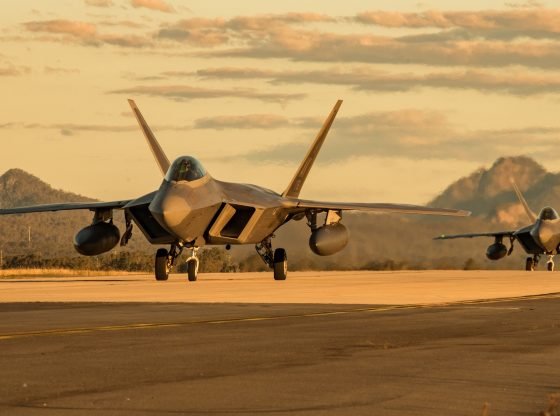
Written by James M. Dorsey.
A podcast version of this story is available on Soundcloud, Itunes, Spotify, Stitcher, TuneIn, Spreaker, Pocket Casts, Tumblr, Podbean, Audecibel, Patreon and Castbox.
The question is not if, but when the long-standing American defence umbrella in the Gulf, the world’s most militarised and volatile region, will be replaced by a multilateral security arrangement that would have to include China as well as Russia.
The United States’ perceived diminishing commitment to the Gulf and the broader Middle East and mounting doubts about the deterrence value of its defence umbrella leave the Gulf stuck between a rock and a hard place. The American umbrella is shrinking, but neither China nor Russia, despite their obvious interests, are capable or willing simply to shoulder the responsibility, political risk and cost of replacing it.
On balance, China’s interests seem self-evident. It needs to secure its mushrooming political and economic interests in the Gulf, which includes ensuring the flow of oil and gas and protecting its infrastructure investment and the expanding Chinese diaspora in the region. Nonetheless, China has so far refrained from putting its might where its money is, free-riding instead (in the words of US officials) on America’s regional military presence.
China’s approach is grounded in the belief that economics rather than geopolitics is the key to solving disputes
Indeed, for the longest time China has been able to outsource the protection of its interests to the United States at virtually no cost. For the US, guaranteeing security in the Gulf has been anchored in an American policy which accepted that maintaining security far beyond the borders of the United States was in America’s national interest, including the protection of Chinese assets. All China needed to do, therefore, was to make minimal gestures such as contributing to the multi-national effort in the Gulf and adjacent waters to counter Somali pirates.
In the meantime, China could pursue a long-term strategy to bolster its capabilities. This included infrastructure projects related to the Belt and Road Initiative (BRI) with dual-purpose potential (such as the strategic ports of Gwadar in Pakistan and Duqm in Oman as well as commercial investment in Dubai’s Jebel Ali), the creation of China’s first overseas military facility in Djibouti, and significant expenditure on upgrading the Chinese armed forces.
All that potentially changed with the rise of US President Donald J. Trump, who advocated an America First policy that attributed little value to past US commitments or to maintaining existing alliances. Hence Trump embarked on a trade war with China – viewed as a strategic competitor – and appeared to fuel rather than resolve regional stability by uncritically aligning American policy with that of Saudi Arabia and Israel and targeted Iran as the source of all evil.
This change has yet to translate into specific Chinese policy statements or actions. Nonetheless, the anticipated shift from a unipolar to a multilateral security architecture in the Gulf has cast a new light on the first-ever joint naval exercise involving Chinese, Russian and Iranian naval forces, as well as China’s seemingly lukewarm support for a Russian proposal for a multilateral security approach in the Gulf.
China was careful to signal that neither the joint exercise nor its closer military ties with a host of other Middle Eastern nations meant it was aspiring to a greater role in regional security any time soon. If anything, both the exercise and China’s notional support for Russia’s proposed restructuring of regional security suggest that China envisions a continued US lead in Gulf security, despite the mounting rivalry between the world’s two largest economies.
The Russian proposal in many ways fits China’s bill. Its calls for a multilateral structure involving Russia, China, the United States, Europe and India that would evolve out of a regional security conference along the lines of the Organisation for Security and Cooperation in Europe (OSCE). While backing Russia’s proposal in general terms, Chinese foreign ministry spokesman Geng Shuang stopped short of specifically endorsing it. Geng welcomed ‘all proposals and diplomatic efforts conducive to de-escalating the situation in the Gulf region’.
China’s reluctance to endorse the Russian proposal more wholeheartedly is rooted in differing approaches towards multilateralism in general and alliances in particular. China shies away from alliances, with their emphasis on geo-economics rather than geopolitics, while Russia still operates in terms of alliances. Despite favouring a continued American lead, China sees a broadening of security arrangements that would embed rather than replace the US defence umbrella in the Gulf as a way to reduce regional tensions.
China also believes that a multilateral arrangement would allow it to continue to steer clear of being sucked into conflicts and disputes in the Middle East, particularly the Saudi-Iranian rivalry. A multilateral arrangement in which the US remained the key military player would further fit the pattern of China’s gradual projection of its growing military power beyond its borders.
With the exception of the facility in Djibouti, China’s projection becomes less hardcore the further one gets from the borders of the People’s Republic. More fundamentally, China’s approach is grounded in the belief that economics rather than geopolitics is the key to solving disputes, which so far has allowed it to remain detached from the Middle East’s multiple conflicts. It remains to be seen how sustainable this approach is in the long term.
Such an approach is unlikely to shield China forever from the Middle East’s penchant for ensuring it is at the heart of the major external parties’ concerns. And as Jiang Xudong, a Middle East scholar at the Shanghai Academy of Social Sciences, puts it: ‘Economic investment will not solve all other problems when there are religious and ethnic conflicts at play’.
Dr James M. Dorsey is a Senior Fellow at the Rajaratnam School of International Studies, Nanyang Technological University, an Adjunct Senior Research Fellow at the National University of Singapore’s Middle East Institute, and Co-Director of the University of Würzburg’s Institute of Fan Culture.
This article was first published by Asia Dialogue